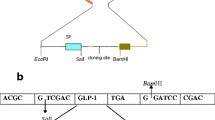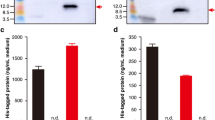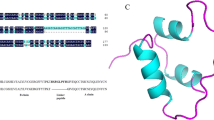Abstract
In recent years, therapeutic peptides have garnered great interest in the pharmaceutical industry for the treatment of diabetes. Lactic acid bacteria (LAB) are an appealing vehicle for safe and convenient oral delivery of bioactive peptide and protein drugs. Exendin-4 (Exd4) is a glucagon-like protein-1 (GLP-1) receptor agonist that is considered an excellent therapeutic peptide drug for type 2 diabetes due to its longer-lasting bioactivity, resulting from resistance to dipeptidyl peptidase 4. We explored Lactococcus lactis with the nisin-controlled gene expression (NICE) system as an oral delivery system for recombinant (r) Exd4 peptide in situ. Heterologous expression and secretion of rExd4 by L. lactis NZ9000/pNZ8048-rExd4 were successful and efficient under the NICE system. In vitro treatment with rExd4 significantly enhanced insulin secretion of INS-1 cells and activated the PI3-K/AKT signal pathway with protein levels of AKT and p-AKT increasing 1.6- to 1.8-fold compared to negative controls, similar to the positive GLP-1 controls. INS-1 cells treated with rExd4 also showed enhanced proliferation and inhibited apoptosis, corresponding with the effects of the standard Exd4 and GLP-1 treatments. Our data suggest that the rExd4 secreted by L. lactis is a bioactive insulinotropic peptide and functional GLP-1 receptor agonist that enhances glucose-dependent insulin secretion and activates the PI3-K/AKT signal pathway; furthermore, it may be involved in improving proliferation and inhibiting apoptosis of INS-1 cells in in vitro treatments. Therefore, L. lactis producing rExd4 may potentially serve as a novel strategy for oral treatment of diabetes.





Similar content being viewed by others
References
Agarwal P, Khatri P, Billack B, Low WK, Shao J (2014) Oral delivery of glucagon like peptide-1 by a recombinant Lactococcus lactis. Pharm Res 31:3404–3414. doi:10.1007/s11095-014-1430-3
Balca’zar JL, De Blas I, Ruiz-Zarzuela I, Vendrell D, Calvo AC, Ma’rquez I, Girone’s O, Muzquiz JL (2007) Changes in intestinal microbiota and humoral immune response following probiotic administration in brown trout (Salmo trutta). Brit J Nutr 97:522–527. doi:10.1017/S0007114507432986
Belmokhtar CA, Hillion J, Ségal-Bendirdjian E (2001) Staurosporine induces apoptosis through both caspase-dependent and caspase-independent mechanisms. Oncogene 20:3354–3362
Bermúdez-Humarán LG, Langella P, Commissaire J, Gilbert S, Le Loir Y, L’Haridon R, Corthier G (2003) Controlled intra- or extracellular production of staphylococcal nuclease and ovine omega interferon in Lactococcus lactis. FEMS Microbiol Lett 224(2):307–313. doi:10.1016/S0378-1097(03)00475-0
Bouttefeux O, Beloqui A, Préat V (2016) Delivery of peptides via the oral route: diabetes treatment by peptide-loaded nanoparticles. Curr Pharm Design 22:1161–1176
Buteau J, Roduit R, Susini S, Prentki M (1999) Glucagonlike peptide-1 promotes DNA synthesis, activates phosphatidylinositol 3-kinase and increases transcription factor pancreatic and duodenal homeobox gene 1 (PDX-1) DNA binding activity in β (INS-1)-cells. Diabetologia 42:856–864. doi:10.1007/s001250051238
Byetta (exenatide) injection: US prescribing information (2014) Wilmington, DE: AstraZeneca LP
Bydureon (exenatide extended-release for injectable suspension): US prescribing information (2014) Wilmington, DE: AstraZeneca LP
Cano-Garrido O, Seras-Franzoso J, Garcia-Fruitós E (2015) Lactic acid bacteria: reviewing the potential of a promising delivery live vector for biomedical purposes. Microb Cell Factories 14:137. doi:10.1186/s12934-015-0313-6
Chae HJ, Kang JS, Byun JO, Han KS, Kim DU, Oh SM, Kim HM, Chae SW, Kim HR (2000) Molecular mechanism of staurosporine-induced apoptosis in osteoblasts. Pharmacol Res 42:373–381. doi:10.1006/phrs.2000.0700
Chen C, Zhu X, Dou Y, Xu J, Zhang J, Fan T, Du J, Liu K, Deng Y, Zhao L, Huang Y (2015) Exendin-4 loaded nanoparticles with a lipid shell and aqueous core containing micelles for enhanced intestinal absorption. J Biomed Nanotechnol 11:865–876. doi:10.1166/jbn.2015.1971
de Ruyter PG, Kuipers OP, de Vos WM (1996) Controlled gene expression systems for Lactococcus lactis with the food-grade inducer nisin. Appl Environ Microbiol 62:3662–3667
Edwards CM, Stanley SA, Davis R, Brynes AE, Frost GS, Seal LJ, Ghatei MA, Bloom SR (2001) Exendin-4 reduces fasting and postprandial glucose and decreases energy intake in healthy volunteers. Am J Physiol Endocrinol Metab 281:E155–E161
Eng J, Kleinman WA, Singh L, Singh G, Raufman JP (1992) Isolation and characterization of exendin-4, an exendin-3 analogue, from Heloderma suspectum venom. Further evidence for an exendin receptor on dispersed acini from guinea pig pancreas. J Biol Chem 267:7402–7405
Engelgau MM, Narayan KM, Herman WH (2000) Screening for type 2 diabetes. Diabetes Care 23:1563–1580. doi:10.2337/diacare.23.10.1563
Gigoux V, Fourmy D (2013) Acting on hormone receptors with minimal side effect on cell proliferation: a timely challenge illustrated with GLP-1R and GPER. Front Endocrinol 4:50. doi:10.3389/fendo.2013.00050
Gundogdu E, Yurdasiper A (2014) Drug transport mechanism of oral antidiabetic nanomedicines. Int J Endocrinol Metab 12:e8984. doi:10.5812/ijem.8984
Hajduch E, Litherland GJ, Hundal HS (2001) Protein kinase B (PKB/Akt)—a key regulator of glucose transport? FEBS Lett 492:199–203. doi:10.1016/S0014-5793(01)02242-6
Hohmeier HE, Mulder H, Chen GX, Henkel-Rieger R, Prentki M, Newgard CB (2000) Isolation of INS-1–derived cell lines with robust ATP-sensitive K+ channel-dependent and-independent glucose-stimulated insulin secretion. Diabetes 49:424–430. doi:10.2337/diabetes.49.3.424
Holst JJ (2007) The physiology of glucagon-like peptide 1. Physiol Rev 87:1409–1439. doi:10.1152/physrev.00034.2006
Kandel ES, Hay N (1999) The regulation and activities of the multifunctional serine/threonine kinase Akt/PKB. Exp Cell Res 253:210–229. doi:10.1006/excr.1999.4690
Kaushal G, Trombetta L, Ochs RS, Shao J (2006) Delivery of TEM beta-lactamase by gene-transformed Lactococcus lactis subsp. lactis through cervical cell monolayer. Int J Pharm 313(1–2):29–35. doi:10.1016/j.ijpharm.2006.01.013
Klijn N, Weerkamp AH, de Vos WM (1995) Genetic marking of Lactococcus lactis shows its survival in the human gastrointestinal tract. Appl Environ Microbiol 61(7):2771–2774
Kuipers OP, de Ruyter PG, Kleerebezem M, de Vos WM (1998) Quorum sensing-controlled gene expression in lactic acid bacteria. J Biotechnol 64:15–21. doi:10.1016/S0168-1656(98)00100-X
Le Loir Y, Gruss A, Ehrlich SD, Langella P (1998) A nine-residue synthetic propeptide enhances secretion efficiency of heterologous proteins in Lactococcus lactis. J Bacteriol 180(7):1895–1903
Ma Y, Liu J, Hou J, Dong Y, Lu Y, Jin L, Cao R, Li T, Wu J (2014) Oral administration of recombinant Lactococcus lactis expressing HSP65 and tandemly repeated P277 reduces the incidence of type I diabetes in non-obese diabetic mice. PLoS One 9:e105701. doi:10.1371/journal.pone.0105701
Mao RF, Wu DL, Hu SM, Zhou KP, Wang M, Wang YF (2017) Secretory expression and surface display of a new and biologically active single-chain insulin (SCI-59) analog by lactic acid bacteria. Appl Microbiol Biotechnol 101:3259–3271. doi:10.1007/s00253-017-8125-8
Mentlein R (2005) Therapeutic assessment of glucagons-like peptide-1 agonists compared with dipeptidyl peptidase IV inhibitors as potential antidiabetic drugs. Expert Opin Investig Drugs 14:57–64. doi:10.1517/13543784.14.1.57
Morishita M, Peppas NA (2006) Is the oral route possible for peptide and protein drug delivery? Drug Discov Today 11:905–910. doi:10.1016/j.drudis.2006.08.005
Ng DT, Sarkar CA (2011) Nisin-inducible secretion of a biologically active single-chain insulin analog by Lactococcus lactis NZ9000. Biotechnol Bioeng 108:1987–1996. doi:10.1002/bit.23130
Peterbauer C, Maischberger T, Haltrich D (2011) Food-grade gene expression in lactic acid bacteria. Biotechnol J 6:1147–1161. doi:10.1002/biot.201100034
Rekha MA, Sharma CP (2013) Oral delivery of therapeutic protein/peptide for diabetes—future perspectives. Int J Pharm 440:48–62. doi:10.1016/j.ijpharm.2012.03.056
Robert S, Gysemans C, Takiishi T, Korf H, Spagnuolo I, Sebastiani G, Van Huynegem K, Steidler L, Caluwaerts S, Demetter P, Wasserfall CH, Atkinson MA, Dotta F, Rottiers P, Van Belle TL, Mathieu C (2014) Oral delivery of glutamic acid decarboxylase (GAD)-65 and IL10 by Lactococcus lactis reverses diabetes in recent-onset NOD mice. Diabetes 63:2876–2887. doi:10.2337/db13-1236
Schägger H (2006) Tricine-sds-page. Nat Protoc 1:16–22. doi:10.1038/nprot.2006.4
Shao J, Kaushal G (2004) Normal flora: living vehicles for non-invasive protein drug delivery. Int J of Pharm 286:117–124. doi:10.1016/j.ijpharm.2004.08.004
Thum A, Hupe-Sodmann K, Goke R, Voigt K, Goke B, McGregor GP (2002) Endoproteolysis by isolated membrane peptidases reveal metabolic stability of glucagon-like peptide-1 analogs, exendins-3 and -4. Exp Clin Endocrinol Diabetes 110:113–118. doi:10.1055/s-2002-29087
Thuret G, Chiquet C, Herrag S, Dumollard JM, Boudard D, Bednarz J, Campos L, Gain P (2003) Mechanisms of staurosporine induced apoptosis in a human corneal endothelial cell line. Br J Ophthalmol 87:346–352. doi:10.1136/bjo.87.3.346
Wang Q, Brubaker PL (2002) Glucagon-like peptide-1 treatment delays the onset of diabetes in 8 week-old db/db mice. Diabetologia 45:1263–1273. doi:10.1007/s00125-002-0828-3
Wang Q, Li L, Xu E, Wong V, Rhodes C, Brubaker PL (2004) Glucagon-like peptide-1 regulates proliferation and apoptosis via activation of protein kinase B in pancreatic INS-1 beta cells. Diabetologia 47:478–487. doi:10.1007/s00125-004-1327-5
Wang M, Gao ZQ, Zhang YG, Pan L (2016) Lactic acid bacteria as mucosal delivery vehicles: a realistic therapeutic option. Appl Microbiol Biotechnol 100:5691–5701. doi:10.1007/s00253-016-7557-x
Wyszyńska A, Kobierecka P, Bardowski J, Jagusztyn-Krynicka EK (2015) Lactic acid bacteria—20 years exploring their potential as live vectors for mucosal vaccination. Appl Microbiol Biotechnol 99:2967–2977. doi:10.1007/s00253-015-6498-0
Xu G, Kaneto H, Lopez-Avalos MD, Weir GC, Bonner-Weir S (2006) GLP-1/exendin-4 facilitates β-cell neogenesis in rat and human pancreatic ducts. Diabetes Res Clin Pract 73:107–110. doi:10.1016/j.diabres.2005.11.007
Zhang B, Li AD, Zuo FL, Yu R, Zeng Z, Ma HQ, Chen SW (2016) Recombinant Lactococcus lactis NZ9000 secretes a bioactive kisspeptin that inhibits proliferation and migration of human colon carcinoma HT-29 cells. Microb Cell Factories 15:102. doi:10.1186/s12934-016-0506-7
Author information
Authors and Affiliations
Corresponding author
Ethics declarations
Funding
This work was founded by the Beijing Advanced Innovation Center for Food Nutrition and Human Health.
Conflict of interest
The authors declare that they have no conflict of interest.
Ethical approval
This article does not contain any studies with human participants or animals performed by any of the authors.
Electronic supplementary material
Supplemental Fig. S1
(PDF 496 kb)
Rights and permissions
About this article
Cite this article
Zeng, Z., Yu, R., Zuo, F. et al. Recombinant Lactococcus lactis expressing bioactive exendin-4 to promote insulin secretion and beta-cell proliferation in vitro. Appl Microbiol Biotechnol 101, 7177–7186 (2017). https://doi.org/10.1007/s00253-017-8410-6
Received:
Revised:
Accepted:
Published:
Issue Date:
DOI: https://doi.org/10.1007/s00253-017-8410-6




